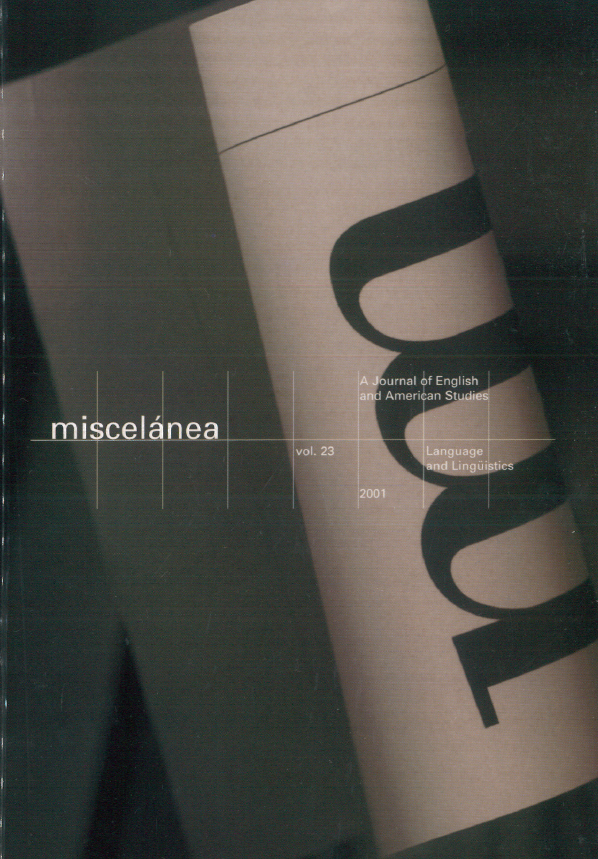Extended Thematic Progression
DOI:
https://doi.org/10.26754/ojs_misc/mj.200110535Keywords:
speech acts, directive acts, commissive acts, cognitivism linguistics, prototype theoryAbstract
Traditional and contemporary accounts of speech acts (Searle 1969, 1979; Wierzbicka 1987) display a great deal of variation regarding the categorization of the acts of threatening, inviting, and offering as either directive or commissive. Given that these three illocutionary types include both directive and commissive features, some speech act theorists, like Bach and Harnish (1979) and Hancher (1979), has postulated the existence of a borderline category of directive-commissive acts, whose members are equally directive and commissive. My aim in this paper is twofold. First, I provide arguments supporting the claim that, in contrast to Bach and Harnish’s and Hancher’s predictions, the illocutionary force of threats, invitations and offers is not directive and commissive in equal proportions. Second, I argue that it is not necessary to posit the existence of a new ad hoc category of directive-commissive speech acts. In the light of cognitive linguistics and prototype theory, the three illocutionary types under consideration can be accommodated as just borderline cases which occupy different intermediate positions along the continuum between the superordinate categories of directive and commissive illocutions.
Display downloads
References
ALCARAZ, Enrique. 1982. Semántica de la novela inglesa. Alicante: Publicaciones de Caja de Ahorros Provincial.
CHATWIN, Bruce. 1990. What Am / Doing Here?. London: Picador.
DANES, Frantisec. (ed.) 1974. Papers on Functional Sentence Perspective. The Hague: Mouton.
DOWNING, Angela. 1996. “Thematic Progression as a Functional Resource in Analyzing Rexts”. In Caneda Cabrera, M.T. y Péroz Guerra (eds.). Os estudios ingleses no contexto das novas, tendencias. Universidad de Vigo: 23-41.
EGGINS, Suzane. 1994. An Introduction to Systemic Functional Linguistics. London: Pinter.
ENKVIST, Nils Erik. 1974. “Theme Dynamics and Style: An Experiment”. Studia Anglica Posnaniensia 5: 127-135.
FIRBAS, Jan. 1992. Functional Sentence Perspective in Written and Spoken Communication. Cambridge. Cambridge University Press.
FRIES, Peter H. 1983. “On the Status of Theme in English: Arguments from Discourse”. In Petöfi, J. S. and E. Sozer. (eds.): 116-152.
GERNSBACHER, Morton Ann and David HARGREAVES. 1992. “The Privilege of Primacy”. In Payne, D.L. (ed.). Pragmatics of Word Order and Flexibility. Amsterdam: John Benjamins: 83-116.
GIORA, Rachel. 1983. “Functional Paragraph Perspective”. In Petöfi, J. S. and E. Sozer. (eds.): 153-182.
GLATT, Barbara. S. 1982. “Defining Thematic Progressions and Their Relationship to Reader Comprehension”. In Nystrand, M. (ed.). What Writers Know: The Language, Process, and Structure of Written Discourse. New York: Academic: 87-103.
HALLIDAY, Michael A. K. 1985. An Introduction to Functional Grammar. London: Edward Arnold.
— and Ruqaia HASAN. 1976. Cohesion in English. London: Longman,
HASAN, Ruqaia. 1984. “Coherence and Cohesive Harmony”. In Flood, J. (ed.) Understanding Reading Comprehension: Cognition, Language and The Structure of Prose. Newark: International Reading Association: 181-219.
HASAN, Ruqaia and Peter FRIES. 1995. On Subject and Theme. Amsterdam: John Benjamins.
HAZADIAH, M.D. 1993. "Topic as a Dynamic Element in Spoken Discourse”. In Baker et al. (eds.) Text and Technology. Philadelphia: John Benjamins: 55-72.
HETZRON, Robert. 1975. “The Presentative Movement or Why the Ideal Word Order is V.S.O.P.”. In Li, Charles N. Word Order and Word Order Change. Austin: University of Texas Press: 347-389.
JONES, Linda. 1977. Theme in English Expository Discourse. Lake Bluff, Illinois: J. Jupiter Press.
LE GUERN, Michel. 1980. La metáfora y la metonimia. Madrid: Cátedra.
LODGE, D. 1977. “Metaphor and Metonymy”. In The Modes of Writing, London: Arnold: 73- 124.
MARTIN, James R. 1992. English Text: System and Structure. Amsterdam: John Benjamins.
MATTHIESSEN, Christian M.I.M. 1992. “Interpreting the Textual Metafunction”. In Davies, M. and L. Ravelli (eds.) Advances in Systemic Linguistics. London: Pinter: 37-81.
PETÖFI, Janos (ed.). 1988. Text and Discourse Constitution. Berlin: Gruyter.
PETÖFI, Janos S and E. Sozer. (eds.). 1983. Micro and Macro Connexity of Texts. Hamburg: Buske.
REINHART, Tanya. 1981. “Pragmatics and Linguistics: An Analysis of Sentence Topics”, Philosophica 27/1: 53-94.
SCINTO, Leonard F.M. 1983. “Functional Connectivity and the Communicative Structure of Text”. In Petöfi, J.S. and E. Sozer. (eds.): 73-115.
—. 1986. Written Language and Psychological Development. New York: Academic Press.
Downloads
Published
Issue
Section
License
Copyright (c) 2001 Pablo Ortega Gil

This work is licensed under a Creative Commons Attribution-NonCommercial 4.0 International License.


